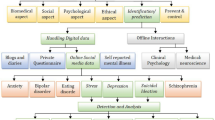Abstract
The landscape of drug abuse is shifting. Traditional means of characterizing these changes, such as national surveys or voluntary reporting by frontline clinicians, can miss changes in usage the emergence of novel drugs. Delays in detecting novel drug usage patterns make it difficult to evaluate public policy aimed at altering drug abuse. Increasingly, newer methods to inform frontline providers to recognize symptoms associated with novel drugs or methods of administration are needed. The growth of social networks may address this need. The objective of this manuscript is to introduce tools for using data from social networks to characterize drug abuse. We outline a structured approach to analyze social media in order to capture emerging trends in drug abuse by applying powerful methods from artificial intelligence, computational linguistics, graph theory, and agent-based modeling. First, we describe how to obtain data from social networks such as Twitter using publicly available automated programmatic interfaces. Then, we discuss how to use artificial intelligence techniques to extract content useful for purposes of toxicovigilance. This filtered content can be employed to generate real-time maps of drug usage across geographical regions. Beyond describing the real-time epidemiology of drug abuse, techniques from computational linguistics can uncover ways that drug discussions differ from other online conversations. Next, graph theory can elucidate the structure of networks discussing drug abuse, helping us learn what online interactions promote drug abuse and whether these interactions differ among drugs. Finally, agent-based modeling relates online interactions to psychological archetypes, providing a link between epidemiology and behavior. An analysis of social media discussions about drug abuse patterns with computational linguistics, graph theory, and agent-based modeling permits the real-time monitoring and characterization of trends of drugs of abuse. These tools provide a powerful complement to existing methods of toxicovigilance.




Similar content being viewed by others
References
RTI International. (2012). National survey on drug use and health: sample redesign issues and methodological studies. http://www.samhsa.gov/data/NSDUH/NSDUHMethodsSIMS2012.pdf. Accessed 5 Jan 2013
Sloboda Z (2002) Changing patterns of “drug abuse” in the United States: connecting findings from macro- and microepidemiologic studies. Subst Use Misuse 37(8–10):1229–1251
Descotes J, Testud F (2005) Toxicovigilance: a new approach for the hazard identification and risk assessment of toxicants in human beings. Toxicol Appl Pharmacol 207(2 Suppl):599–603
Eysenbach G (2009) Infodemiology and infoveillance: framework for an emerging set of public health informatics methods to analyze search, communication and publication behavior on the internet. J Med Internet Res 11(1):e11
McNeil K, Brna PM, Gordon KE (2012) Epilepsy in the twitter era: a need to re-tweet the way we think about seizures. Epilepsy Behav: E&B 23(2):127–130
Boyer EW, Wines JD Jr (2008) Impact of internet pharmacy regulation on opioid analgesic availability. J Stud Alcohol Drugs 69(5):703–708
Barratt MJ (2012) Silk road: eBay for drugs. Addiction 107(3):683
Lange JE, Daniel J, Homer K, Reed MB, Clapp JD (2010) Salvia divinorum: effects and use among YouTube users. Drug Alcohol Depend 108(1–2):138–140
Cavnar WB, and Trenkle JM (1994). N-gram based text categorization. Proc. of SDAIR-94, 3rd Annual Symposium on Document Analysis and Information Retrieval, pp. 161–175
Ziv J, Lempel A (1977) A universal algorithm for sequential data compression. IEEE Trans Inf Theory 23(3):337–343
Hu J, Gao J, Principe JC (2006) Analysis of biomedical signals by the Lempel–Ziv complexity: the effect of finite data size. IEEE Trans Biomed Eng 53(12 Pt 2):2606–2609
Hastie T, Tibshirani R, Friedman J (2009) The elements of statistical learning: data mining, inference, and prediction, 2nd edn. Springer, New York
Dumais S (2005) Latent semantic analysis. Annu Rev Inf Sci Technol 38:188
Davis ME, Sigal R, Weyuker EJ (1994) Computability, complexity, and languages: fundamentals of theoretical computer science. Academic, Boston
Bondy J, Murty U (2008) Graph theory. Graduate texts in mathematics, 3rd edn. New York, Springer
Watts DJ, Strogatz SH (1998) Collective dynamics of ‘small-world’ networks. Nature 393(6684):440–442
Cha M (2012) The world of connections and information flow in Twitter. IEEE Trans Syst Man Cybern 42(4):991–998
Graham RL, Groetschel M, Lovasz L (eds) (1996) Handbook of combinatorics, vols 1 and 2. Elsevier, Amsterdam
Schrodinger E (1944). What is life? The physical aspect of the living cell. Dublin: e Dublin Institute for Advanced Studies at Trinity College
Macklem PT (2008) Emergent phenomena and the secrets of life. J Appl Physiol 104(6):1844–1846
Acknowledgments
The authors would like to acknowledge Emily H. Park and Julia Sun for their help in preparing this manuscript.
Conflict of interest
None.
Author information
Authors and Affiliations
Corresponding author
Additional information
Description of R21 program announcement:
The theories outlined in this paper will serve as the basis for an R21 grant application. The R21 grant mechanism is intended to encourage exploratory/developmental research by providing support for the early and conceptual stages of project development.
Rights and permissions
About this article
Cite this article
Chary, M., Genes, N., McKenzie, A. et al. Leveraging Social Networks for Toxicovigilance. J. Med. Toxicol. 9, 184–191 (2013). https://doi.org/10.1007/s13181-013-0299-6
Published:
Issue Date:
DOI: https://doi.org/10.1007/s13181-013-0299-6




